Blog, Kashmiri Culture
Old Kashmir Photos with Detailed History
History behind the pics is written by Mr Showkat Rasheid Wani
Amira Kadal bridge
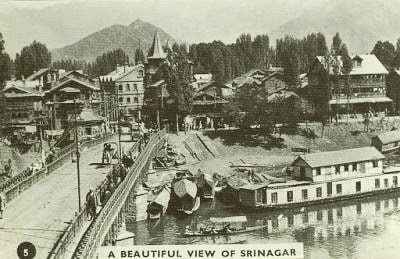
The photograph was taken by M/S Dutta Photographers in 1930’s showing a view of Old Amirakadal. Please appreciate the traffic sense of pedestrians all of them are crossing the bridge through footpath. On the right one can see a double-story Houseboat. It was the only Houseboat Hotel in Kashmir it was named “Kashmir Hindu Hotel” it had 12 Guest Rooms in it. It was dismantled in May 2007 Photograph will be uploaded separately.
The white building across the Bridge is Gurdwara Singh Sabah it was inaugurated on 28th Baduin 1970 Bikrimi corresponding to 1914 AD. Koh-i- Suliman & Zaberwan hills can also be seen in the far background.
Fort and Jamia Masjid

Atta Mohammad Khan built fort crowning Koh-i-Marran can be seen in the background. On the left one can see one of the corner spires of Jamia Masjid. The date of the Photograph should be 1870 as it seems that Jamia Masjid is still not been repaired. Repairs were started in 1871.
MAQDOOM SAHIB 1901
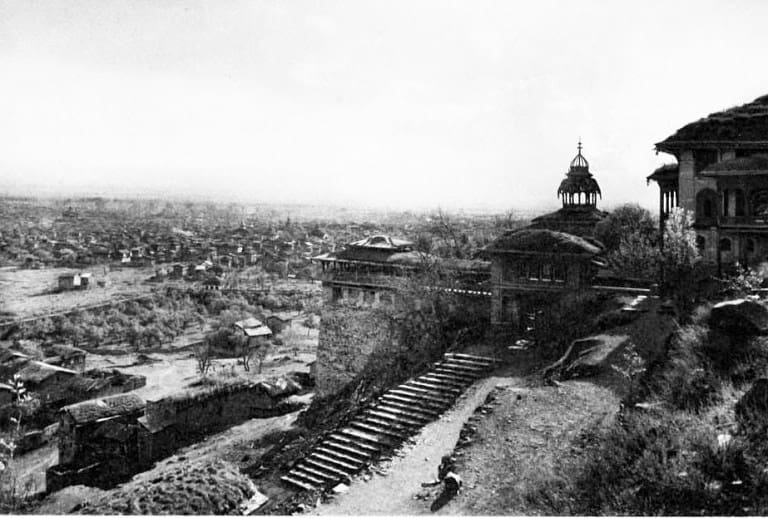
The photograph of ZIARAT SHARIEF HAZRAT SHEIKH HAMZA MAQDOOM SAHIB(RA) has been taken by H.R.H. Prince Luigi Amadeo of Savoy, Duke of the Abruzzo. In 1901 AD during his visit to Kashmir & it’s Provinces.
One of the most sacred Ziarat (Shrines) of Kashmir is situated on the south side last Koh-i-Marran under the Atta Mohmmad Khan built Fort Hari Parbat. The large complex houses Roza Shariefs of Hazrat Sultan ul Aarfeen (RA) & Hazrat Dawood Khaki (RA) . Masjid Jahangir , Masjid Salar Beg, Zakir Masjid,Jafar Salar,Mariam Mahal, Masjid Atta Mohmmad Khan, Baradari,Saria Khas& Sacred Tank. The construction of the original Roza SHARIEF was ordered by Emperor Akbar in 1597 AD. Jamia Masjid . Naagar Nagar Wall (Kalai) around Koh-i-Marran can also be seen.
House crews of students of CMS Central School
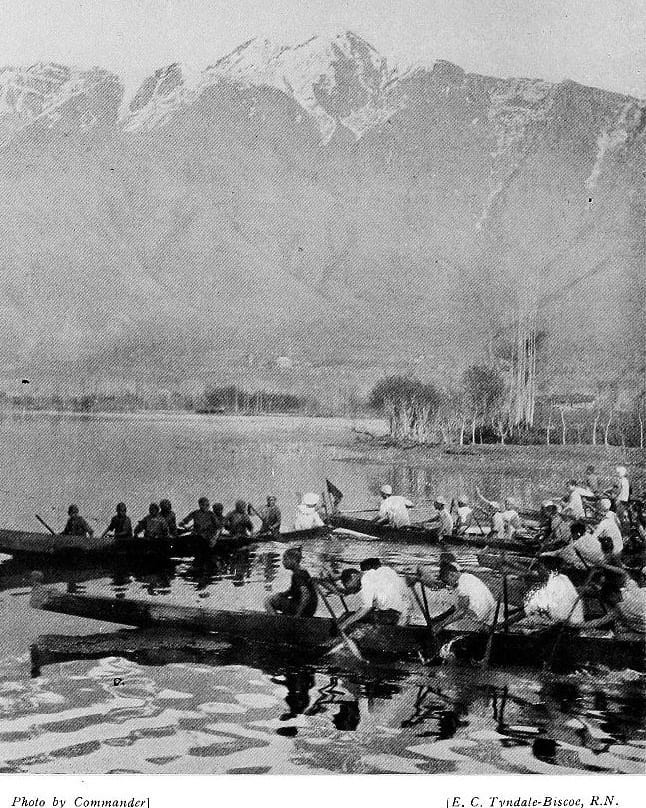
Photograph was taken by Rev. Tyndale Briscoe in late 1920’s showing House crews of students of CMS Central School Fateh Kadal at Regatta in Dal Lake. This photograph was first published in the book authored by Rev. Tyndale Biscoe titled ” KASHMIR IN SUNLIGHT AND SHADE” in 1922. In those days swimming was made compulsory. Any boy who could not swim after he was 12 years of age had to pay extra fees. It won’t be out of place to mention here that in those days CMS Central School was at Fateh Kadal. It had branches at
Habba Kadal
Rainawari
Amira Kadal
Ali Kadal
Soottoo Barber Shah
Besides, there was a High-school Branch in Islamabad.
Hari Parbat Fort
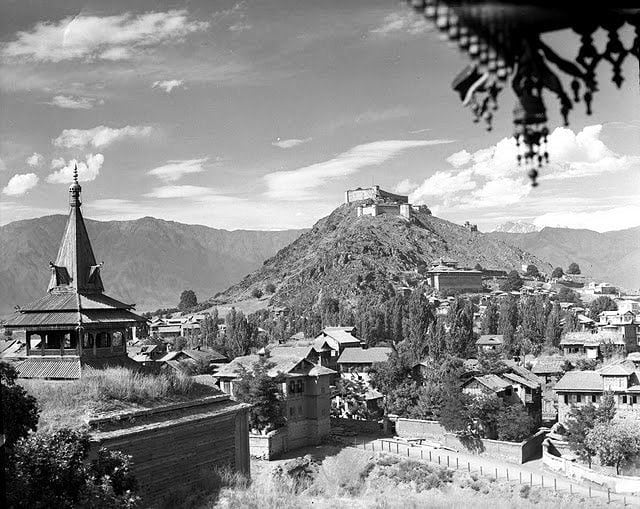
Photograph taken by Robert Keagal in 1945 from back spire of Jamia Masjid. In this photograph, Atta Mohmmad Khan built Fort(now known as Hari Parbat Fort) crowning Koh-i-Marran, with Ziarat Maqdoom Sahib (RA) on the south side of the hillock. Even the Iconic Chinar of “Kastoor Penh” can also be seen right of Ziarat. One thing to note is that Jamia Masjid has “Burza Peash
Scout Ambulance
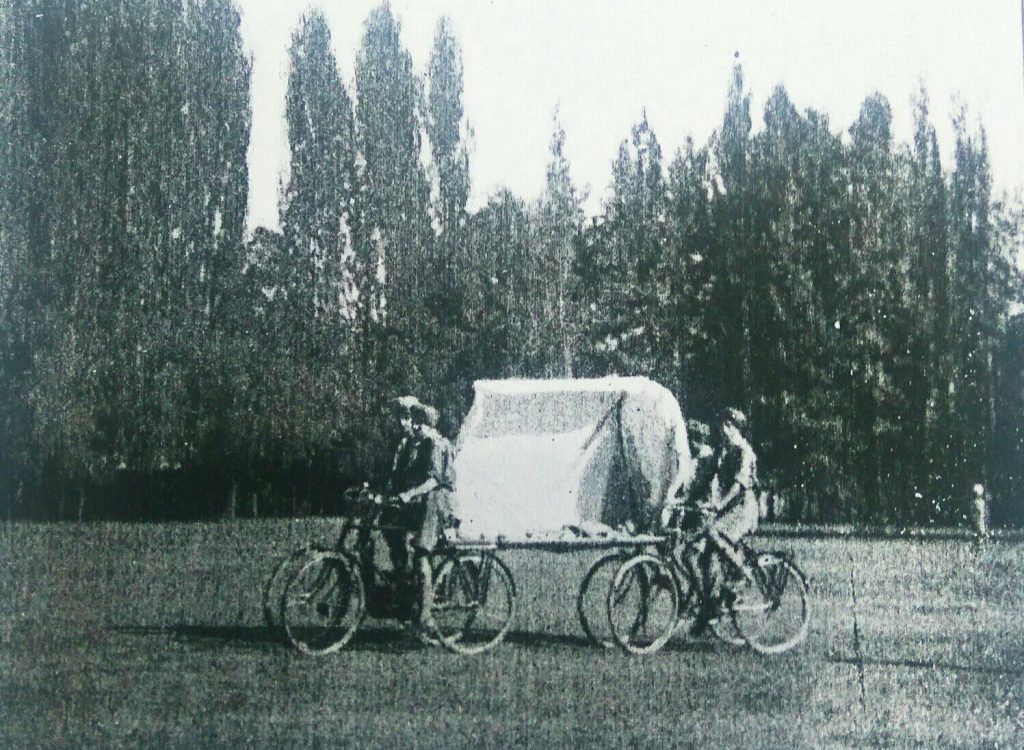
CMS School Sheikh Bagh had constructed a Bicycle driven “Scout Ambulance”. Photograph taken by Mrs. S.W.Steane in 1927 showing the Bicycle Ambulance being displayed in the play ground of the School.
Tonga Adda
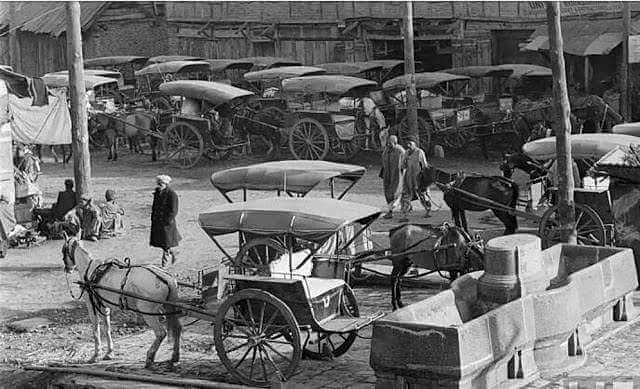
Photograph taken by Howard Schreuk for Life Magazine in 1953 showing Tonga Adda at now a days Budshah Chowk. This adda was shifted once the Budshah bridge was ready in 1957 & approach roads had to be made it.
Gagribal Point
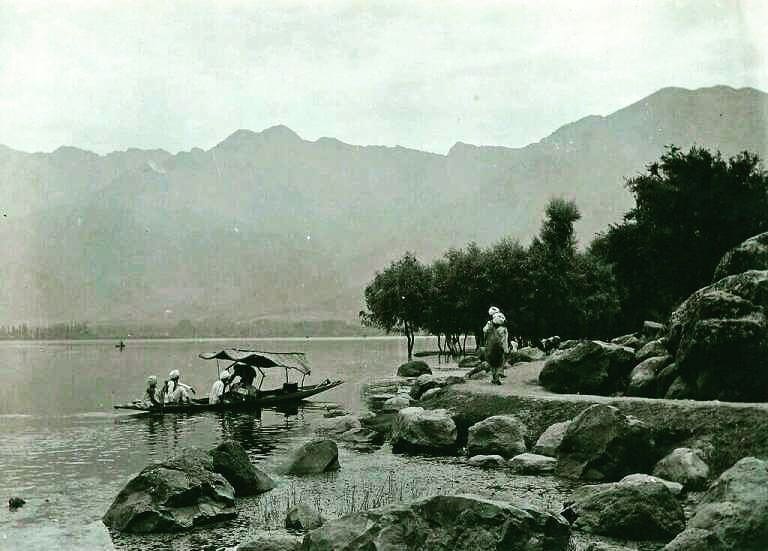
This photograph taken from Gagribal Point by R.B.Holmes in 1910 showing view of Dal Lake with a “Chatte” Shikair approaching the shore. In those days there was no road around the lake. The spot is exactly where Police Station Nehru Park is now located. The construction of first phase of the road along the lake from Dal Gate upto Brein Kralsangree was taken in hand under the supervision of Engr. Green in 1928 & was completed in 1931, it was named “Karan Boulevard”
Old Lal Chowk
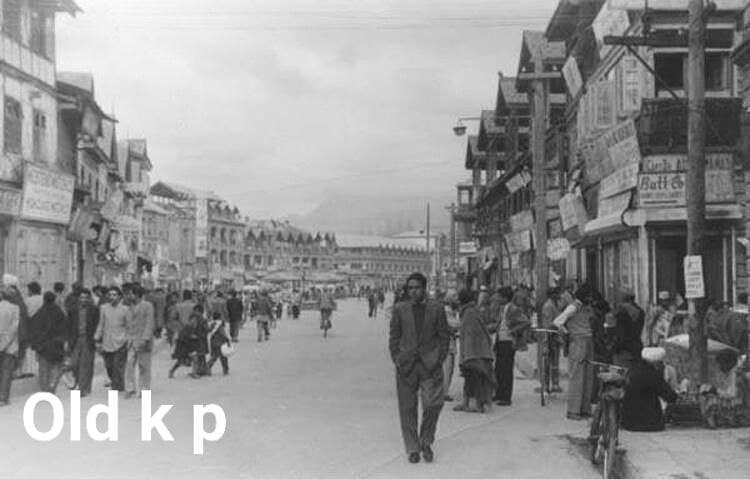
This photograph of Lal Chowk Area is of late 1950’s as in far background Lala Rukh Hotel building can be seen construction of which was started in 1956. The first building on right in the photograph is of present-day Hotel Standard & next to it is “Ismail Building” which was completely destroyed in a fire in February 1990 & a new one has been built in its place.
The Bund
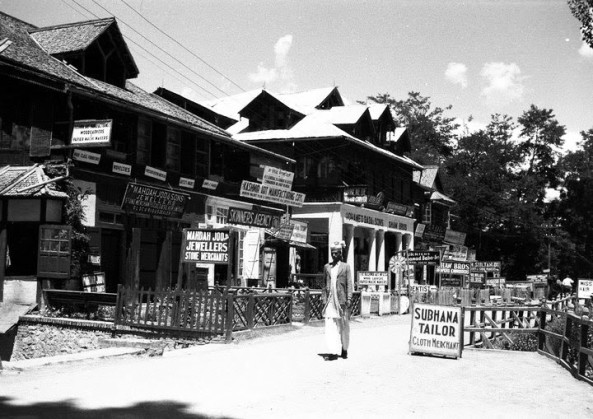
The photograph has been taken by Robert Keegal in 1945. It shows a view of the portion of “The Bund ” as it was then between Present-day Ahdoos Hotel & JK Bank Polo View Branch. Only the building at the far end is still in the same position others have been dismantled & constructed new or extended.
Bund was constructed after 1903 floods. In those days it was used by British & European tourists for their visits to bank, Post Office & General & Photography stores such as W.D.Lambert’s. Nobody was allowed to ride a bicycle on Bund even up to the late 1960s.
Baramulla bridge
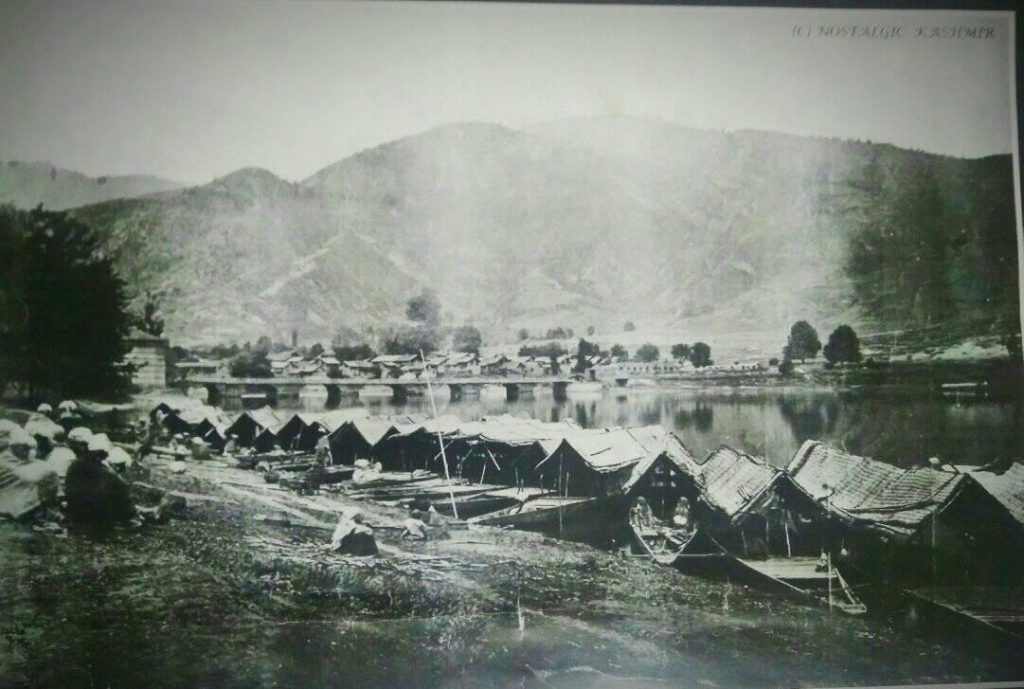
Photograph taken by Edward Sache in 1889 of Baramulla bridge from upstream side.. Doonga Taxi Boats can be seen moored on the Ghat to ferry customers from khadanyar to Srinagar & beyond to Khanabal on the Veath. Old town of Baramulla can be seen in the back ground.
3rd bridge
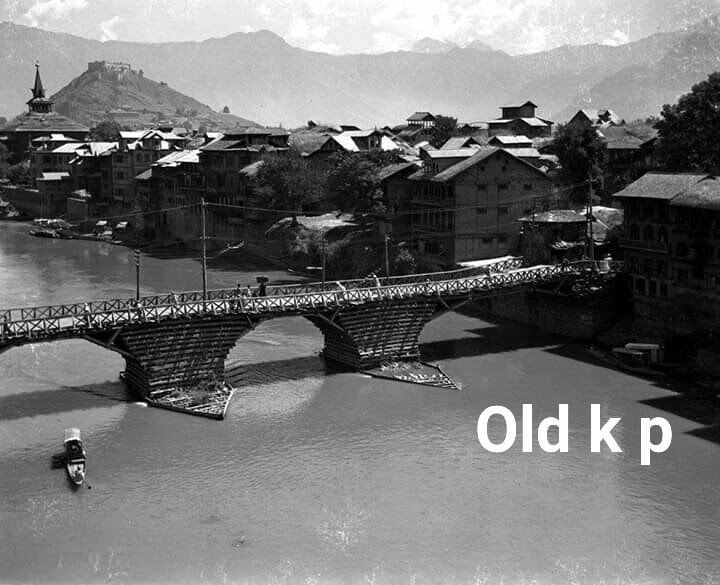
This photograph is of 3rd bridge . In those days Srinagar was known as the city of seven bridges. Fateh Kadal was the 3rd bridge. This photograph has been taken by R.C.Mehta & is a classic one. In this one can see Fateh Kadal in foreground whereas Shah Hamadan Khanqah, Koh-i-Marran crowned by Atta Khan built fort & the lone Chinar of “Kastoor Penj” can be seen. Zaberwan hills range can be seen in the distance.
The bridge in the photo was built in 1902 by Maharaja Partap Singh , at the same place where the original bridge built by Sultan Fateh Shah in 1520AD stood. Which was repaired from time to time till it was destroyed beyond repair in the great floods of 1893AD.
Near present day Sri Partap Singh Museum at Lal Mandi
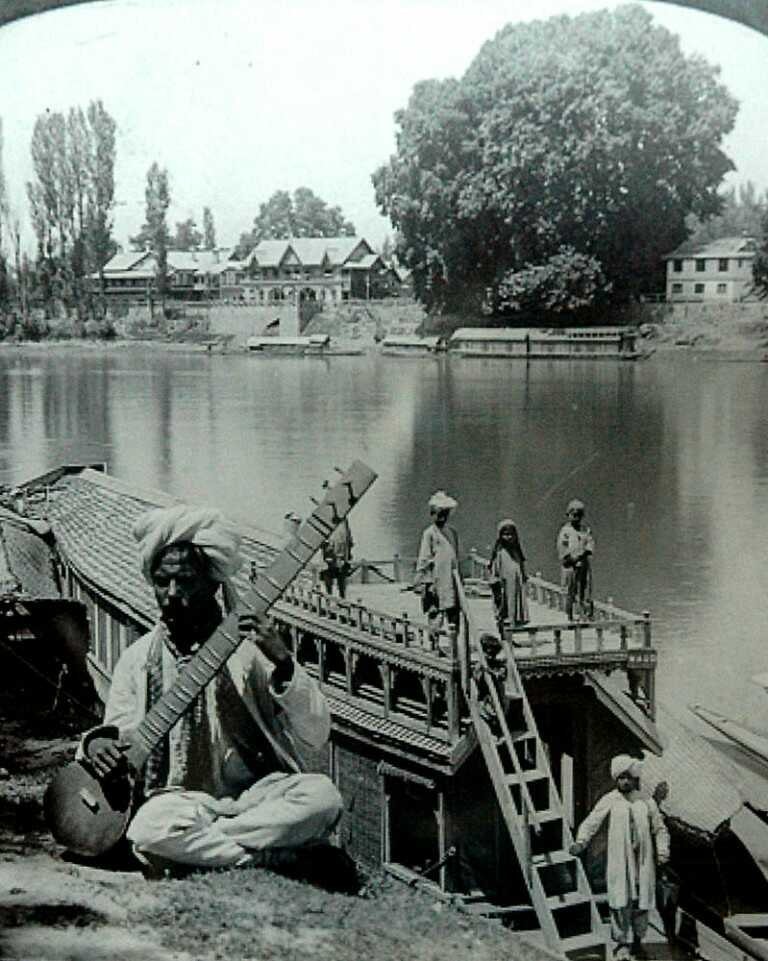
Photograph taken by James Ricalton in 1903 from left bank of Veath near present day Sri Partap Singh Museum at Lal Mandi. In those days it used to be Royal Guest House & Ball Room. This is half of Stereoview / Stereoscopic Photograph showing a detailed view of House Boat ,Kitchen Boat ,Shikara , Houseboat owner & his family. Musician can be seen posing with his string musical instrument. Across the river one can see a view showing the building housing the British Residency then. Christian Cemetery is also there.
Cart road to Islamabad
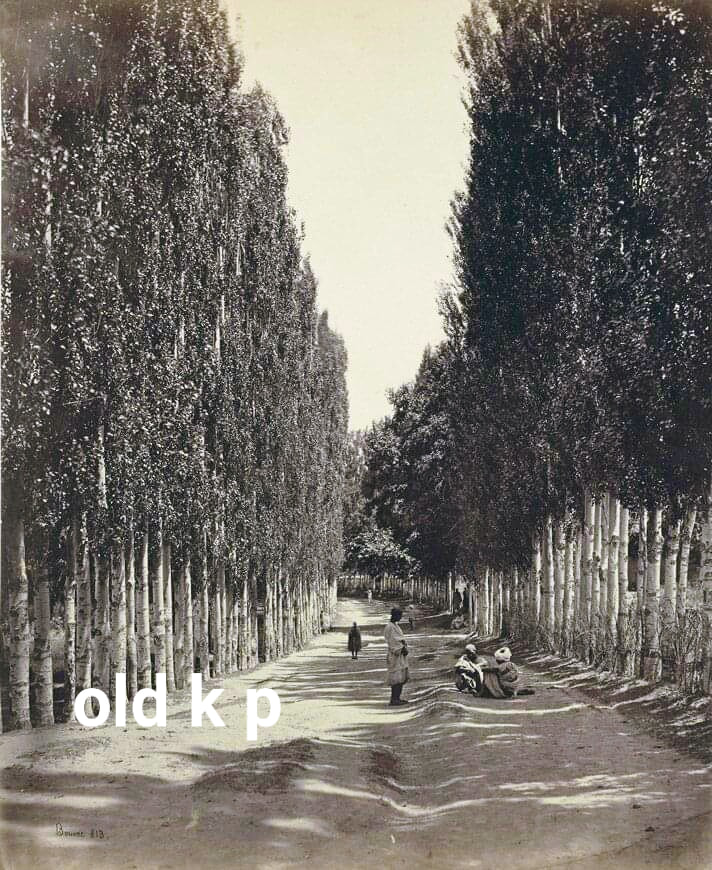
Photograph has been taken by Samuel Bourne in 1860’s showing a view of Poplar lined cart road leading to Islamabad from Srinagar. Mr. Samuel Bourne a bank clerk by profession was an amature Photographer ,he visited Kashmir in 1863, 1864 & lastly in 1868. He has taken a lot of Photographs of Kashmir showing a visual history of those days.
Old Maulana Azad Road
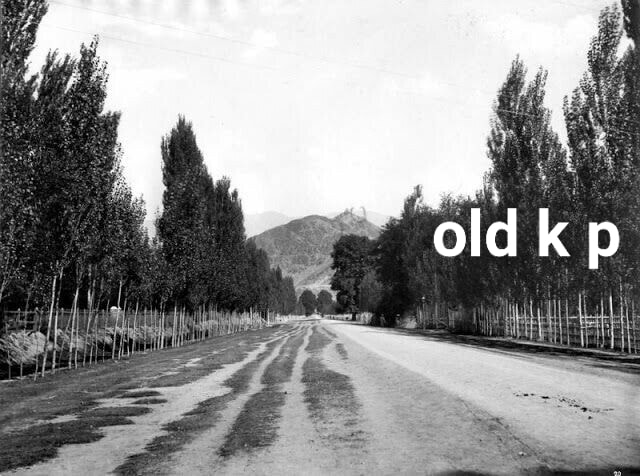
Photograph taken in 1911 of the Hotel Road looking towards Takht-e-Sulieman. This road now known as Maulana Azad Road is a mile & quarter-long was originally laid by Pathan Governor of Kashmir in 1809 & still the longest straight road in Srinagar. This road was used as a horse race course starting from the bridge over “Tzchunt Kul” which used to be known as “Gur Dav Kadal” upto present-day Budshah Chowk. The bridge has been reconstructed and is now known as Maulana Azad Bridge.
Poplars were planted on both sides of the road & as such was also known by the British as Srinagar Poplar Avenue.
However the name changed to “Hotel Road” after the first European Style Nedou’s Hotel built in early 1900’s by traveller / architect Michael Adam Nedou from Ragusa— a Croatian heritage walled city on Adriatic Sea started operations. The old Poplars planted during the Afgan rule along the Avenue were cut down in 1890’s and fresh new Poplars were planted along the sides of the road along with 15 Chinars which have been there since then.
In those days Takht-e- Suliaman was void of any vegetation/trees.
Foundation Kashmir University
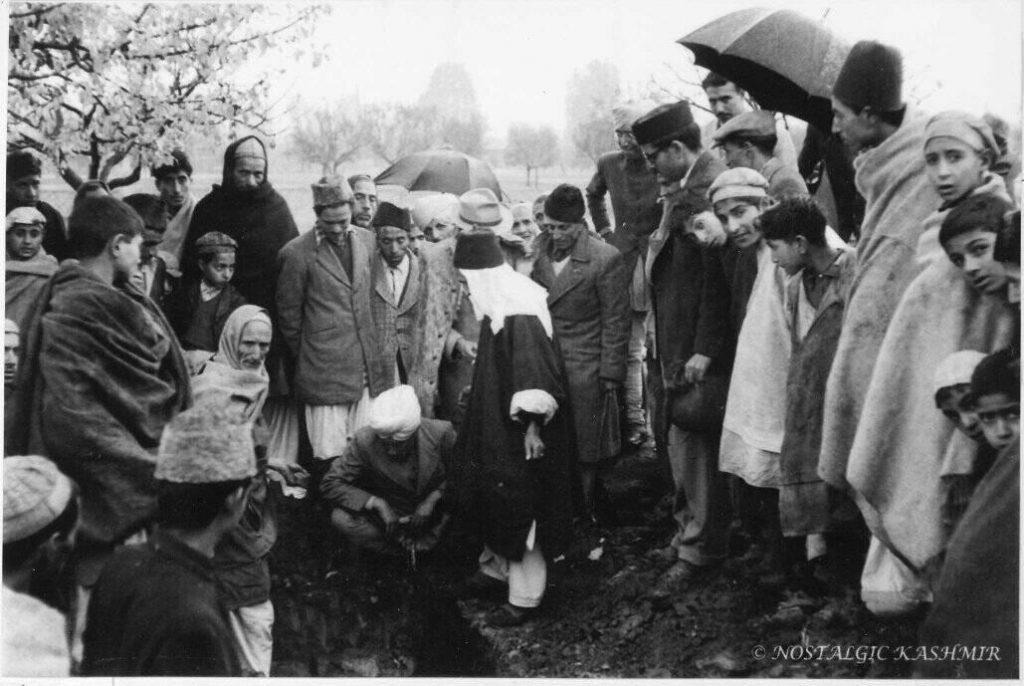
Photograph showing foundation Stone laying ceremony of the J&K University led by Jenab Syed Meerak Shah Kashani Sahib (RA) in 1956. In this photograph a Kashmiri Pundit Priest can also be seen in the congregation. In 1956 the setting up of university campus was taken in hand at Amar Singh Bagh a 120 Acre Orchard next to Dargah Hazratbal which was donated for this purpose by The Sadar-e- Riyasat Of J&K Dr. Karan Singh.
Sraan Kout
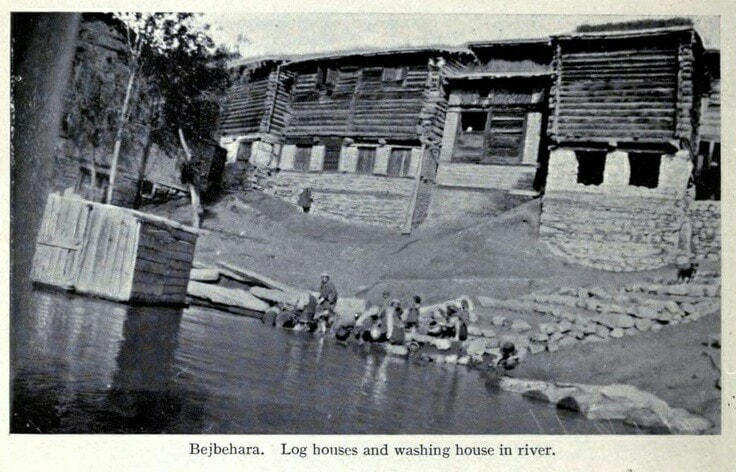
Photograph taken by A. Prtrocokino for his book titled” CASHMERE” Three Weeks in a Houseboat. first published in 1920.In the photograph taken at Bijbihara shows ladies busy in washing clothes & utensils at Yaarbal. A bathroom “Sraan Kout” can be seen on the left submerged in water.
Hanji Woman
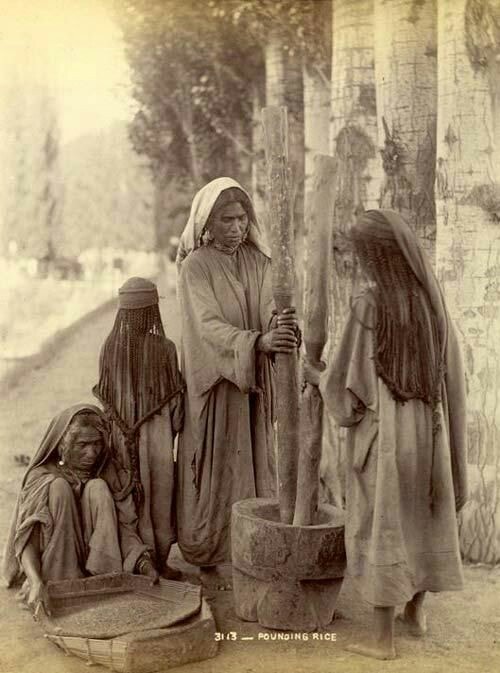
This photograph is from British Library Archive’s taken in 1877 with no mention of the Photographer. It shows two hanji ladies pounding Paddy to get rice for the family in a wooden mortar “Kaanz” with the help of wooden Pestles ” Muhul” An older lady is winnowing pounded rice with a “Shuup”. One very peculiar thing to be noticed is the typical Hanji women Hairstyles
Jehlum Valley Road
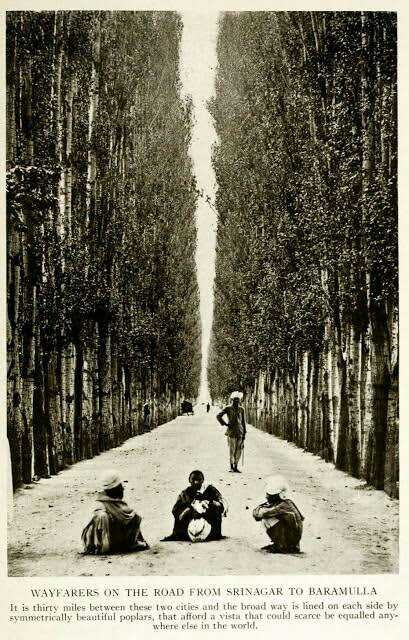
Photograph taken by F.Ward Denys in early 1910’s showing view of Poplar lined Jehlum Valley Road between Pattan & Baramulla. In 1915 it was published in his book titled “OUR SUMMER IN VALE OF KASHMIR”
Kashmiri Pandit Women
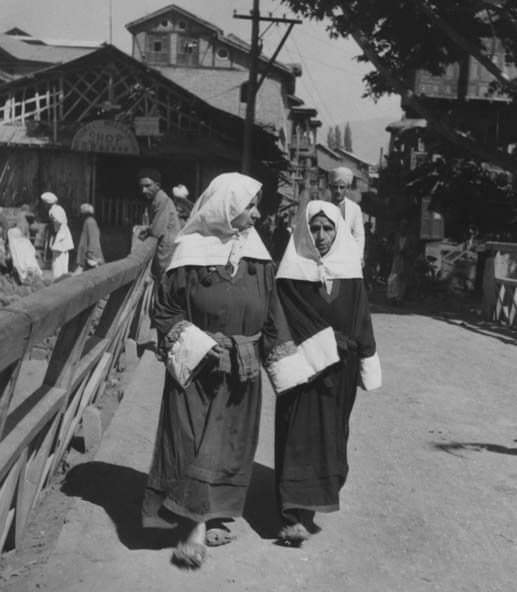
The photograph taken in 1949 showing two Kashmiri pandit Ladies crossing Berbershah Bridge wearing their traditional attire. Both are wearing Ankle length Phearns with Laadh, a loongi used as Kamarband (Hol Gandun), head covered by Pooczh under which Kashmiri Pandits women used to cover head by Tarang. Lady on the left is wearing Dejhoor & has Nerwar on pheran sleeve indicating her marital status of being married & husband still alive. One interesting thing noticeable is that both are wearing “Pulhoer” as their footwear it used to be made of paddy grass. I will try to upload a photo of Pulhoer
Fateh Kadal
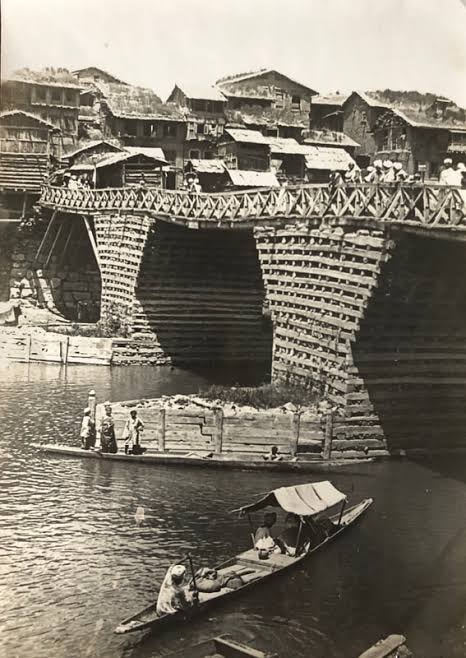
Photograph taken in 1870’s is from British Library Archive. Fateh Kadal was originally constructed by Sultan Fateh Shahin 1520 AD.The bridge was repaired from time to time however it got extensively damaged during the great floods of 1893AD. It was completely dismantled & reconstructed at the same place by Maharaja Partap Singh in 1902 . The bridge was 300ft long &32 ft wide .
Rambagh

It is a photograph taken by Francis Firth in late 1870’s showing children playing ” AAREO MAAREO TAAREYO TICH” in the middle of a dirt road near Rambagh. This game used to be a popular means of selecting teams for other games.
Nallah mar
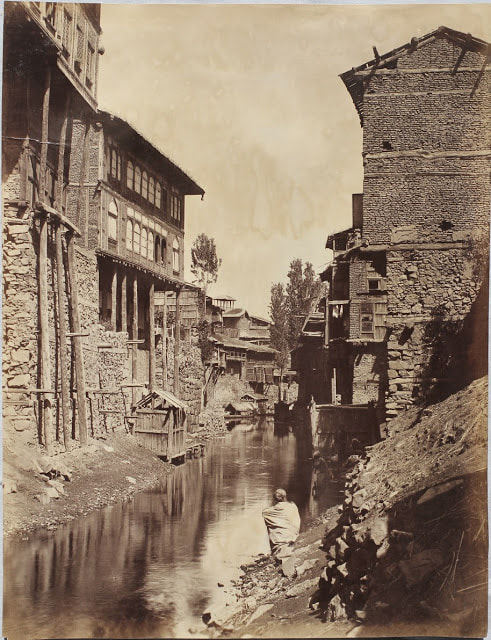
Photograph taken by Francis Firth in 1870 showing the Shanty dwellings on both banks of Nallah-e- Mar somewhere in Sher–e- Khas. The Mar Kul was a 200 mile long natural & man made irrigation cum navigation canal system starting from Marser Lake. Commencement of work on the man-made portion has been credited to Raja Bak in 532 BC. Mar kul had nine bridges across it from Khanyar to Chattaba. This portion was built by Zain-ul-Abidin Budshah. The same was filled up for construction of Mar Plan Road in 1970’s.
Lal Mandi Gath
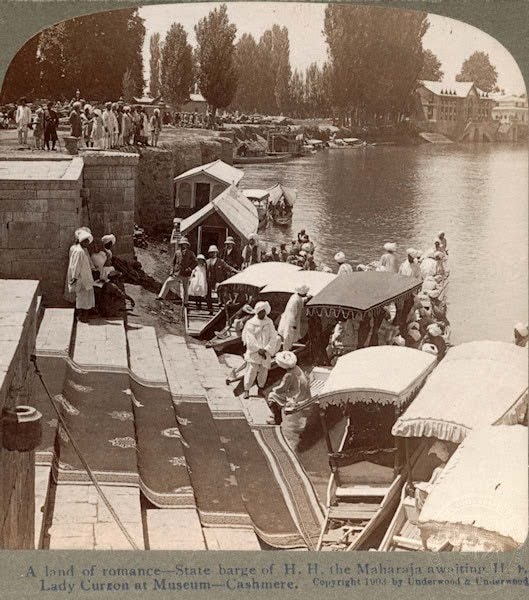
This photograph has been taken in 1903 at Lal Mandi Gath where the Royal Barges (Parandhs) are waiting for Lord & Lady Curzon to be taken to SherGarhi Palace. Lal Mandi Complex those days used to be Royal Guest House & Ball Room. State Hospital can be seen down stream in the left bank of Veath( Jehlum).
Dal Darwaza
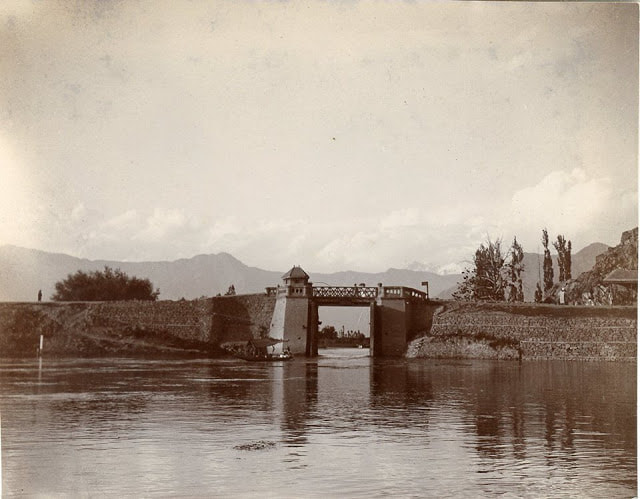
Photograph showing newly constructed Dal Darwaza in 1898 from Tzchunt Kul. The original Dal Darwaza which stood at the same spot was washed away in the floods of july 1893.The Dal Darwaza was used to regulate the outflow of Lake water into River Jehlum & Vice-versa during floods. For passage through the gate the boats used to be pulled manually with ropes as the water used to gush out of the lake & there used to be many accidents at this spot. The Lock gate was constructed later to prevent recurrence of accidents.
Saraf Shop
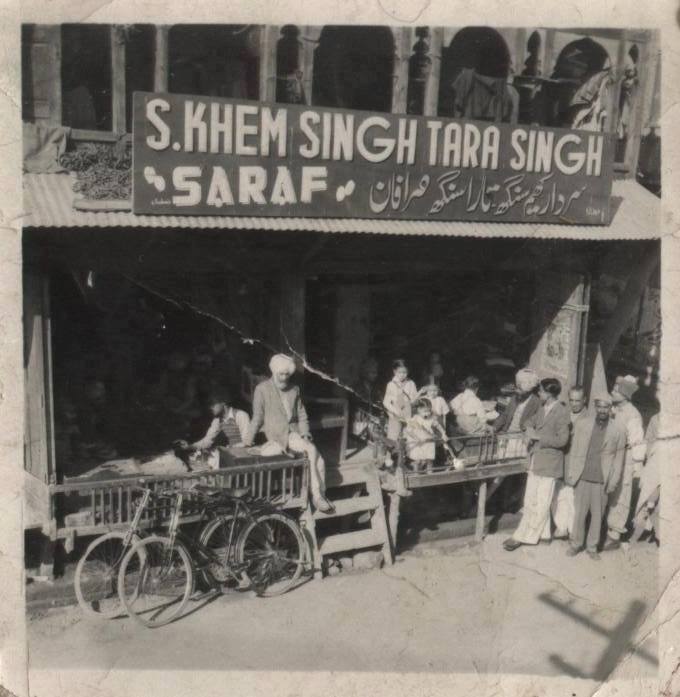
The family history is “The shop was opened by Thaker Singh ji in 1850. Later on Khem Singh ji and Tara Singh ji s/o Thaker singh ji flourished the name of the shop. Tara Singh ji s/o Thaker Singh ji and Seva Singh ji s/o khem singh ji worked together afterwards. Now a days the shop is in the hands of Amar jit Singh ji s/o Seva Singh ji .”AND Mehtab Singh was cousin of Thaker Singh ji . Photo taken in 1953

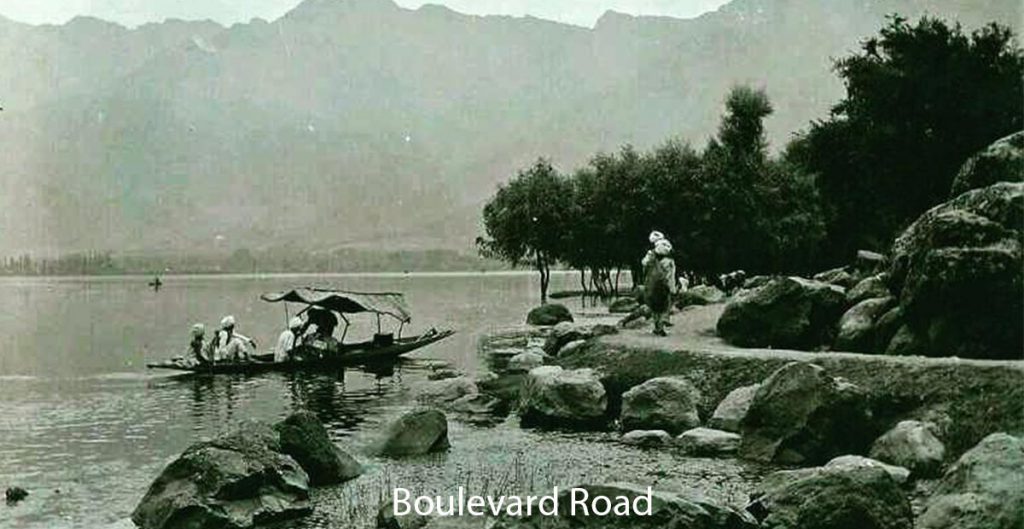
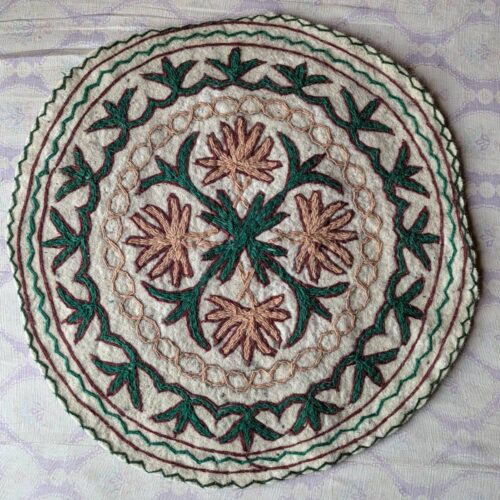
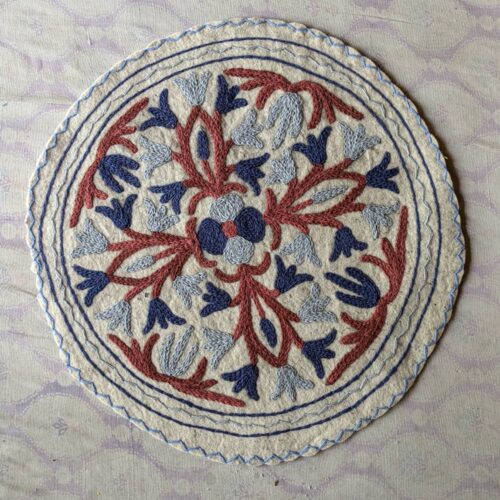
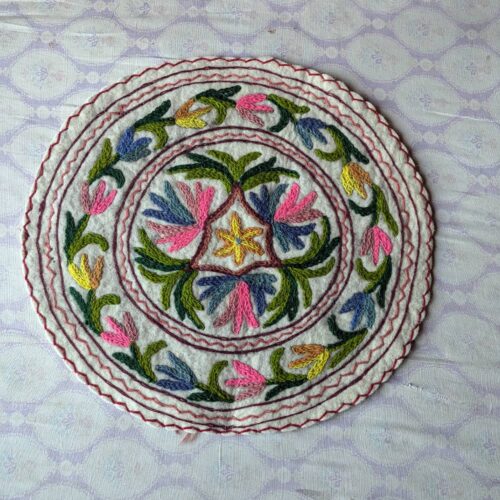



Interesting to go through our glorious past,simplicity was everywhere,thnk u for publishing.
handwritten books were made,
I am stunned to see what we had who had done this how had done this and what we are going through what a beautiful past we had love u My Paradise The Holy Kashmir.